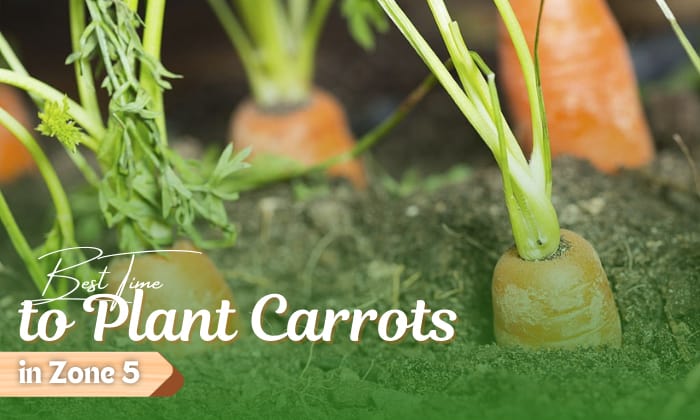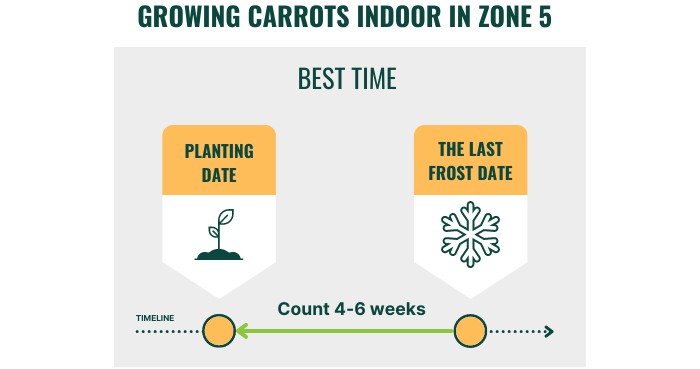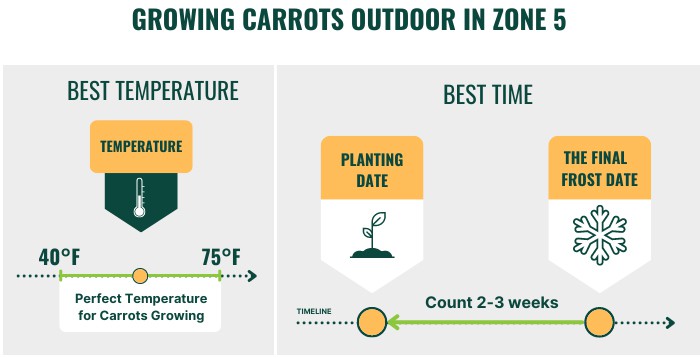Carrots are known for their health benefits. Because they are considered a cool-weather crop, this plant can grow in places with mild temperatures like USDA zone 5.
In this particular region, carrots can be sown around March 25 to April 10 in the spring or from September 20 to 30 in the fall. Read this planting guide to know more about when to plant carrots in zone 5 and more!
Table of Contents
Zone 5 Planting Schedule
When should I sow carrot seeds? While it is highly recommended to do your carrot zone 5 gardening during the spring season, another schedule option is in the fall.
1. Spring planting schedule
- Indoor
When to start seeds indoors? When opting to cultivate your seeds indoors, ensure the utilization of healthy soil. The soil should possess a fine texture and be compacted densely within starting trays with a minimum depth of 2 inches.
Planting time: The best time to plant carrot seeds indoors is four to six weeks before the last frost.
- Outdoor
Proper soil temperature is one of the major requirements for your carrots to germinate properly. Ideally, it should be 40 degrees to 75 degrees F. Extreme weather conditions, especially excruciating hot temperatures, can prevent your seedlings from attaining their optimal growth.
Planting time: When planting carrots directly in the outdoor garden, remember to sow the seeds approximately 2 to 3 weeks or 20 days before the final frost date in spring.
Since zone 5 has an average last frost of April 7, the approximate dates for planting are February 25 to March 10 indoors and March 17 to 24 outdoors.
2. Fall planting schedule
There are instances where you may miss the springtime planting schedule. You may refer to the vegetable planting calendar (for early spring vegetables) provided by the university extension office where you live.
Generally speaking, people can do their zone 5 carrot planting on September 20 to September 30, or around ten weeks before the first frost.
Just make sure to follow this planting chart:
| Days to Maturity | Fall Planting Dates | Distance Between Rows | Distance Between Plants | Sowing Depth |
| 70-80 | September 20 to September 30 | 2 ½ ft. | 2 inches | ¼ to 1/2 inch |
Tips and Tricks to Planting Carrot Seeds in Zone 5
1. Do not slack!
Planting your carrots early before the average last frost is recommended. This allows you to take advantage of the cool temperature that is beneficial for germination and early growth.
2. Water regularly
Ensure the soil remains uniformly damp throughout the germination process, usually spanning 1 to 3 weeks.
Subsequently, administer thorough, yet infrequent watering to stimulate the development of extensive root systems in the carrot seedlings. Be cautious not to excessively water, as this may result in root decay or division. An inch of moisture per week will suffice.
3. Mulch to retain moisture
Cover the carrot plants with a protective layer of organic mulch like shredded leaves or straw. Mulching conserves moisture, prevents weeds, and stabilizes soil temperatures.
4. Watch out for pests
Watch out for garden pests like carrot rust flies, and aphids. Consider using insecticidal soaps or floating row covers to safeguard young seedlings from insect harm. Consistently eliminate weeds to avoid nutrient and space competition.
5. Harvest carrots
Harvest carrots by using a garden fork to dig around the plant. It takes about two months for these crops to reach maturity, so mark your calendar accordingly.
You can expose carrots to one mild frost for sweeter flavors if planting in the fall, but make sure to pick the root crops once they’re 0.5-inch wide for better taste.
Recommended Carrot Varieties
Presented below are five carrot cultivars that are ideally suited for cultivation in USDA Zone 5:
- Bolero: Esteemed for its reliable performance in cold climates, this variety has strong resistance to splitting and can withstand low temperatures. It produces deliciously sweet, cylindrical carrots with a rich orange color.
- Scarlet Nantes: An enduring heirloom selection known for its crunchy texture and delightful sweetness. It excels in cooler climates like Zone 5, with cylindrical roots displaying vibrant orange.
- Danvers: Highly regarded for their superb flavors, Danvers carrots have a conical shape and adapt well to diverse climates, including zone 5. They exhibit excellent resistance to cracking and have a commendable shelf life.
- Chantenay: Chantenay carrots have a shorter and broader stature and are suitable for heavy clay soils. They have a smooth texture and pleasant sweetness and thrive in cooler climates.
FAQs
Do carrots need to grow in the sun?
Yes, carrots require total sun exposure to thrive. They need at least 8-10 hours of direct sunlight daily for optimal growth and development.
How long does it take for carrots to germinate?
Carrots typically take around 14 to 21 days to germinate. However, germination time can vary depending on the temperature, moisture, and carrot variety.
Can I plant carrots without the seed?
Carrots are typically grown from seeds, but you can also grow them from carrot tops or scraps. While it is possible to regrow carrot greens from the top portion of a carrot, developing a new carrot root from scraps is challenging and not recommended for consistent results.
Conclusion
Remember, it’s all about finding when to plant carrots in zone 5. The sweet spot is between frosty winters and scorching summers. Proper timing can give those little orange warriors the perfect conditions to sprout and conquer your garden.
So, grab your gardening gloves, embrace the rhythm of the seasons, and embark on a carrot-growing journey that will leave you crunching with delight in no time. Happy planting, zone 5 adventurers!

Hi, I am William – Floridayards’ digital content creator. My job is to find answers to all your concerns with thorough research and our team’s expert advice. I will also bring you honest reviews on the best products and equipment for raising your beautiful garden. Please look forward to our work!



















